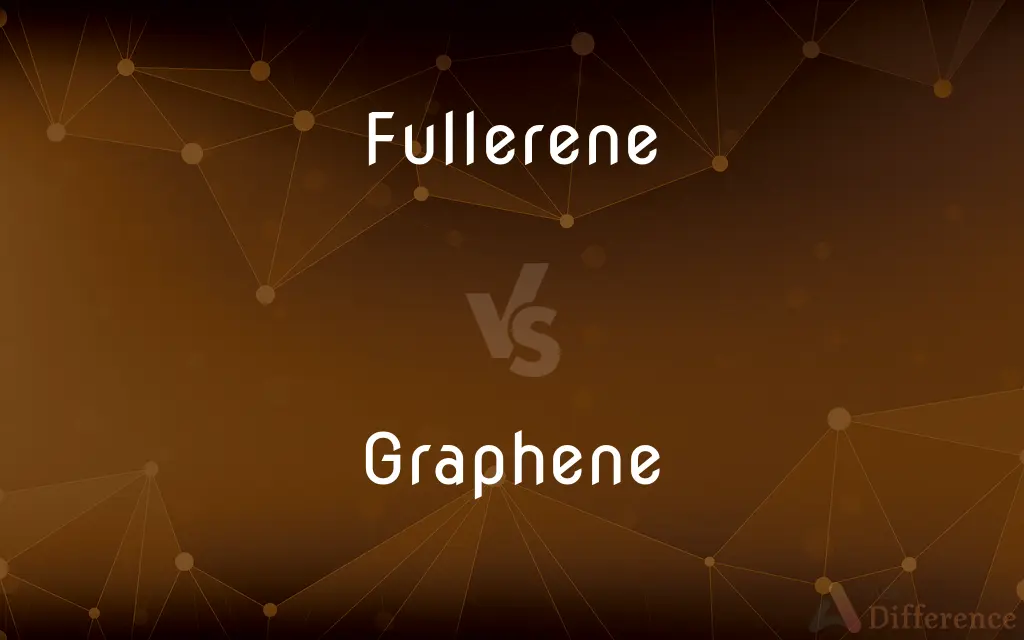Fullerene vs. Graphene — What's the Difference?
By Maham Liaqat & Urooj Arif — Updated on April 24, 2024
Fullerene consists of spherical, closed-lattice structures of carbon, while graphene features a single layer of carbon atoms in a two-dimensional hexagonal lattice.

Difference Between Fullerene and Graphene
Table of Contents
ADVERTISEMENT
Key Differences
Fullerene, comprised of carbon atoms linked to form a closed sphere or ellipsoid, exhibits properties that stem from its unique hollow structure. Graphene, on the other hand, is a flat monolayer of carbon atoms tightly packed into a two-dimensional honeycomb lattice, giving it remarkable electrical conductivity.
Fullerenes are typically found in forms such as C60, which resembles a soccer ball with both hexagonal and pentagonal patterns. Graphene, whereas, consists purely of hexagonal patterns, which contribute to its exceptional strength and flexibility.
The electronic properties of fullerenes vary significantly because of their molecular curvature and enclosed structure, which can trap electrons. In contrast, graphene is highly conductive, allowing electrons to move freely at high speeds across its surface.
In practical applications, fullerenes are often used in pharmaceuticals and advanced materials due to their ability to encapsulate other molecules. Graphene, on the other hand, is leveraged in electronics and energy storage solutions, exploiting its high conductivity and large surface area.
Fullerenes absorb light well across the visible spectrum and are investigated for use in solar cells and photosensitive applications. Whereas graphene's optical properties include high transparency and the ability to conduct electricity, making it ideal for touch screens and even transparent conductive displays.
ADVERTISEMENT
Comparison Chart
Structure
Spherical, closed lattice
Flat, open lattice
Atom Arrangement
Hexagons and pentagons
Hexagons only
Conductivity
Lower due to enclosed structure
Very high, electrons move freely
Light Absorption
High across visible spectrum
High transparency
Applications
Pharmaceuticals, advanced materials
Electronics, energy storage, transparent displays
Compare with Definitions
Fullerene
Can form allotropes such as buckminsterfullerene and carbon nanotubes.
Buckminsterfullerene's unique shape inspired its name after architect Buckminster Fuller.
Graphene
Acts as an excellent thermal conductor.
Graphene is explored for use in thermal management applications in electronics.
Fullerene
Used in drug delivery systems due to its ability to encase other molecules.
Fullerene cages are being explored for targeted cancer therapies.
Graphene
Used to improve the conductivity and strength of composite materials.
Graphene composites are used in high-performance sports equipment.
Fullerene
A molecular structure composed of carbon atoms arranged into a closed mesh, forming spheres or tubes.
C60 fullerene is often referred to as a buckyball due to its resemblance to a soccer ball.
Graphene
Potential applications in ultrafast electronics.
Graphene transistors are being developed for next-generation computer chips.
Fullerene
Acts as a superconductor under certain conditions.
When doped with alkali metals, fullerene exhibits superconductivity.
Graphene
Transparent and flexible, suitable for touch screens.
Graphene-based touch panels are emerging in smart device markets.
Fullerene
Utilized in the manufacture of photovoltaic cells.
Fullerene derivatives are components in some organic solar cells.
Graphene
Consists of a single layer of carbon atoms in a two-dimensional hexagonal lattice.
Graphene is often highlighted for its strength, which is stronger than steel.
Fullerene
A fullerene is an allotrope of carbon whose molecule consists of carbon atoms connected by single and double bonds so as to form a closed or partially closed mesh, with fused rings of five to seven atoms. The molecule may be a hollow sphere, ellipsoid, tube, or many other shapes and sizes.
Graphene
Graphene () is an allotrope of carbon consisting of a single layer of atoms arranged in a two-dimensional honeycomb lattice. The name is derived from "graphite" and the suffix -ene, reflecting the fact that the graphite allotrope of carbon contains numerous double bonds.
Fullerene
An allotrope of carbon composed of any of various cagelike molecules that consist only of an even number of carbon atoms, are often spherical in shape, and are composed of hexagonal and pentagonal groups of atoms.
Graphene
A monolayer of carbon atoms having a hexagonal lattice structure and constituting a basic structural element of graphite, fullerenes, and carbon nanotubes.
Fullerene
(inorganic chemistry) Any of a class of allotropes of carbon having hollow molecules whose atoms lie at the vertices of a polyhedron having 12 pentagonal and 2 or more hexagonal faces.
Graphene
(organic chemistry) Any polycyclic aromatic hydrocarbon having the structure of part of a layer of graphite.
Fullerene
(organic chemistry) Any closed-cage compound having twenty or more carbon atoms consisting entirely of 3-coordinate carbon atoms.
Graphene
(inorganic chemistry) An arbitrarily large-scale, one-atom-thick layer of graphite, an allotrope of carbon, that has remarkable electric characteristics.
Fullerene
The class of carbon allotropes consisting of tubular carbon molecules (carbon nanotubes) and spheroidal carbon molecules (traditional fullerenes).
Fullerene
A form of carbon having a large molecule consisting of an empty cage of sixty or more carbon atoms
Common Curiosities
What are the main differences in the molecular structure of fullerene and graphene?
Fullerene has a closed spherical structure that can include hexagons and pentagons, while graphene is an open, flat structure consisting only of hexagons.
Why is graphene considered revolutionary in materials science?
Graphene's exceptional mechanical, thermal, and electrical properties make it revolutionary for numerous applications.
What is fullerene used for?
Fullerene has applications in drug delivery, cosmetic products, and organic photovoltaics.
What is the impact of graphene in electronics?
Graphene is used to create faster, more efficient electronic devices with its high electron mobility.
Are there any environmental concerns associated with fullerene and graphene?
There are concerns about the environmental impact and toxicity of nanoscale materials, including fullerenes and graphene.
What are carbon nanotubes?
Carbon nanotubes are cylindrical molecules made of carbon atoms, structurally related to fullerenes.
Can graphene be used in medical applications?
Graphene is explored for use in biosensors, drug delivery, and tissue engineering due to its biocompatibility and mechanical properties.
What makes fullerene unique in its chemical properties?
Fullerene's unique spherical structure allows it to encapsulate other molecules, making it useful in drug delivery and other applications.
How is graphene produced?
Graphene can be produced by chemical vapor deposition, mechanical exfoliation, or reduction of graphene oxide.
How does graphene's thermal conductivity benefit industrial applications?
Its high thermal conductivity makes graphene ideal for applications requiring efficient heat dissipation, such as in electronic devices.
Can fullerene conduct electricity?
Fullerenes can conduct electricity but are less effective compared to graphene due to their molecular structure.
What are the potential applications of fullerene in energy storage?
Fullerene is investigated for its role in organic photovoltaics and energy storage devices due to its ability to accept electrons.
How do fullerene's optical properties compare to those of graphene?
Fullerene absorbs a wide spectrum of light, useful in solar cells, whereas graphene is highly transparent, beneficial for electronic displays.
Is graphene biodegradable?
Graphene is not biodegradable, which poses challenges for its disposal and environmental management.
How does the strength of graphene compare to that of steel?
Graphene is significantly stronger and lighter than steel, which is why it's considered for various structural applications.
Share Your Discovery

Previous Comparison
Gilt vs. Sow
Next Comparison
Balance vs. RemainingAuthor Spotlight
Written by
Maham LiaqatCo-written by
Urooj ArifUrooj is a skilled content writer at Ask Difference, known for her exceptional ability to simplify complex topics into engaging and informative content. With a passion for research and a flair for clear, concise writing, she consistently delivers articles that resonate with our diverse audience.














































